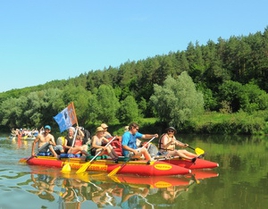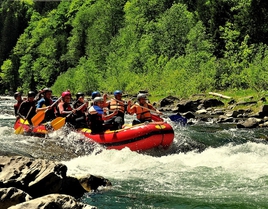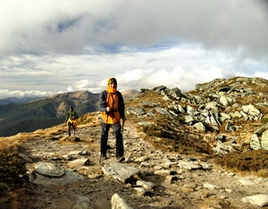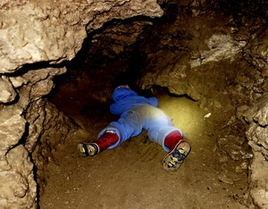The scenario of the Dniester formation
The river network of Dniester in the formation of its modern structure passed several stages. The scenario of formation of the hydrographic network is closely related with the history of emergence and development of Carpathian mountains. About 8 mln. years ago the teritory of modern Carpathians was a mountain arrey with the altitudes much lower than are observed nowadays.
|
|
|
| Pict. 1 Direction of movement of pliocene rivers in Podillya |
Pict. 2 Modern hydrographical network of Ukrainian Carpathians and the direction of watercourses in miocene |
The Carpathian mountan were moving toward southwest - northeast (picture 1). Two facts prove this version. The first is that the uplands of main watercourses of the region: Dniester, Prut and Seret kept this direction to the present time. The second is a well-known fact that the whole teritory of Podillya consists areas covered with Carpathian pebble. In the beginning of the previous century that was observed across nowadays Dniesters-Bugs watershed and even on the left banks of Southern Bug. The caliber of pebble differs from 0,4 to 1,7cm, with average about 0,4-0,5cm. It is quite clear, that to form such a considerable accumulation of pebble must be a permanent watercourses from Carpathian mountains to Podillya for a long period. In this article an old hydrogeographical network of the region won't be resumed. Proceeding therefrom, picture 1 schematically shows the direction of rivers runoff from mountain range to an ancient lowland. More detailed examination of this subject have to be a purpose of a specific research.
Due to gathered information one more conclusion may be made - a river Dniester at the beginning of pliocene couldn't flow along the Carpathian ridge, becouse in ths case it wouldn't bring to Podillya ancient pebble. Natural question arises - where runresearched river in the beginning of pliocene?
The Pre-Dniester of that times in M. I. Dmitriev's opinion, flow out from Carpathian region and fell into Sarmat sea near nowadays Vinnytsya. There are several proofes of this version. First, the upper part of the waterflow remaied the directionfrom southwest to northeast. It turns to southeast only near Chaykovychi, 100km far from its origins. Another proof is the rest of valley-like lowlands or "dead " valleys along the line Ostropil - Khmilnyk. And finally the traces of old estuarine area about 18 000square km between Ostropil and Khmilnyk.
Similar oppinion followed another researcher - well-known geographer of the beginning of XX century - S. Rudnytskiy. In his opinion, Dniester in pliocene was a plaintype river with a lots of manders.
Based on analysis of contemporary data the reconstruction of Pre-Dniester river was made (picture 2). According to this version the watercourse of the old flow match with contemporary Dniester in the section from origins to Chaykovychi. Furhter, Pre-Dniester through the teritory of Roztotchya, partly on the place of nowaday rivers Poltva, Western Bug, Seet, Goryn'. Next section of an ancient waterflow passed by streambeds of Ikva, Southern Bug, by contemporary Khmilnyk to Vinnytsya. As an elevated array Roztotchya appeared much later, it means the possibility of passing through this teritory by ancient Dniester.
Pre-Dnester system included also rivers Syan and Vyr - flowing into is tributaries - Blozhevka and Strvyazh (picture 2). During pliocene the sea receded from Podillya and it became a large valley. A system of rivers were located there, flowing toward southeast direction, as the inclination was slight. Picture 2 schematically shows the flows of 8 pliocene rivers, reconstruied by K. I. Gerenchuk, and the shoreline of Sarmat sea. In general, Podillya of pliocene period, in opinion of this author, reminiscents of contemporary Kuban' lowland.
Somerset of the river-network type held in late pliocent, when the teritory felt mighty tectonic uplifts. Their maximum occurred in northeastern Podillya, in the arrays Gologory and small Polissya junction. The terrain was elevated to altitude about 100-300m. It is quite clear that such events were followed by radical reorganization of whole hydrogeographical network.It leaded to a fadeaway of some rivers at old valley, including Pre-Dniester. The reality of these events is prooved by pabble, which lies higher the the level of rivers flowing from the mountains. This circumstance enabled K. I. Gerenchuk to make a conclusion about the priority of clastic material accumulation followed by the elevation of Podillska plate.
Thanks to the new meridional inclination in Podillya began to form the new system of rivers, to flow from north to south. The springhead of pliocene Dniester played the main role in development of its contemporary valley.
Another important factor is the appearence of periodically changing glaciers.
The researched area was influenced by glaciers several times. Some authors consider, that uppe Dniester and  Roztotchya region was covered with ice during the Dnipro's glaciation.
Roztotchya region was covered with ice during the Dnipro's glaciation.
Its perfectly clear, that restructuring of rivers system was amplified by large volumes of water from melting glaciers. However, the riverbeds movement to southeast was complicated and created many meanders. The river pierced its way, breaking elevated Podilska plate. By the scheme of hydrographic system care clearly traced sections, where it moves to northwest (where ancient sea was), and then again to southeast (picture 2). The serial changes of Dniester riverbed repeats in Prechornomorian lowland.
Based on this schema of development may be suggested an explination - why thre are no right tributaries on section from Nyzhniv till Dubossary.
To find out the reason, some development stages of neighbour Prut must be exemined. In opinion of P. M. Tsysya, that waterflow existed within contemporary waterbed since the beginning of pliocene. At the beginning Pre-Prut was running in the direction of Podilska lowland. Preserved upperfows of the river is orientated from southwest to southeast. As a result of Podilska plates elevating and of tectonic processes in Carpathians - the river Prut break through the "Dobrotvors'ki Gate". It caused the reverse of riverbed for 900, so the river occupied her current position. Gradually was formed curent hydrographical system with its tibutaries, equal from both sides of Prut. According to the data of V. M. Klaptchuk, exactly in pliocene period occured the most intensive deepening of the riverbed for about 70m. It means that Prut occupied the south of Chernivtsi region before Dniester. This caused the absence of tributaries on the right side of Dniester all the way it runs parallel to Prut. Hydrogeographic network between those waterflows became a part of Pruts watershed before Dniester apeared at the area. In general, relations between two rivers are quite aggressive. For example, the river Bystrytsa Nadvirnianska at first was a tributary of Prut, but after Stanislavska plain lowered, it was intercepted by dniester.
Approximetely by the end of late pliocene Dniester its current position on Podilska Upland. The changes of shoreline of ancient seas were a complicated process, and influenced waterbeds of flows.
The researched river has a widen section from Khotyn till Novodniestrovsk stretching 264km. Prut also has a widen section from Novoselytsya till Lypkany sized 40,5km. This indicates the period in development, common for both flows, when they were running from the west to the east and fell into ancient sea in the central part of Ukraine.
Further scenario of formation of the moldovan plot of Dniester was influenced by the regression of ancient water bodies and glaciers activities. The retreat of he sea aroused the formation of Prechrnomorska Lowland, and its suothwestern part was later occupied by Dniester. The process was greatly contributed by two south-east oriented valleys - believes I. V. Izmailov. One of them, situates on the Mogyliv-Rybnytsya line. Another passes through Reut river and part of Dniester too.
In quaternary period, in opinion of I. V. Izmailov, there took place essential crustal uplift. This led to capture by Dniester the second valley and to adherence the Reut river. As a result of these events Dniester turned to 750 near Rybnytsya, where was formed its meridional section from this point till Grygoropol city.
Furter, the researched river made a few more twists, avoiding terrain folds till got to the Dniester Estuary.
The result of current research is following scenario of the formation of Dniester network, including such stages as:
- Dniester of pliocene flowed through the north of contemporary Podillya and fell into Sarmat sea near Vinnytsya;
- Dniester of late pliocene partly occupied its current position and flowed widely forward Vendychany, Tulchyn;
- at the end of pliocene Dniester occupied Prychrnomorska Lowland.
The hypothesis explains the exsistence on right side of Dniester watershed a section without any tributaries stretched for almost 700km.
For tour to Dniester formulations of foreign passport are not required as the main part of the river locates within Ukrainian borders.






